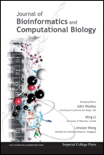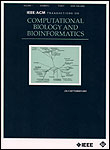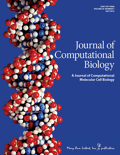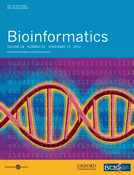
Journal of Bioinformatics and Computational Biology
Scope & Guideline
Exploring the Intersection of Biology and Computer Science
Introduction
Aims and Scopes
- Computational Analysis of Biological Data:
The journal emphasizes methodologies for analyzing complex biological data, including genomic, transcriptomic, proteomic, and metabolomic datasets. It encourages the development of algorithms and tools that enhance data interpretation and biological insights. - Integration of Machine Learning and AI:
A significant focus is placed on integrating machine learning and artificial intelligence techniques into bioinformatics. This includes predictive modeling, classification tasks, and data mining approaches to uncover patterns in biological data. - Network and Systems Biology:
The journal covers research related to biological networks, such as protein-protein interactions, gene regulatory networks, and metabolic pathways. It explores how these networks contribute to biological functions and disease mechanisms. - Structural Bioinformatics:
Research on the computational modeling of biomolecular structures and interactions is a core area. This includes studies on protein-ligand interactions, structural prediction, and the development of tools for structural analysis. - Omics Technologies and Applications:
There is a consistent focus on the application of bioinformatics tools to various omics technologies (genomics, transcriptomics, proteomics, etc.), facilitating the understanding of biological processes and disease mechanisms.
Trending and Emerging
- Deep Learning Applications:
There is an increasing trend in utilizing deep learning techniques for various bioinformatics applications, including drug discovery, protein structure prediction, and genomic data analysis. This trend reflects the growing sophistication and effectiveness of these models in handling complex biological data. - Graph-Based Approaches:
Emerging research is focusing on graph-based models for representing biological data, particularly in drug-target interactions and metabolic networks. This reflects a broader trend towards using graph theory to understand complex biological relationships. - Predictive Modeling for Drug Discovery:
The journal is witnessing a surge in studies aimed at predicting drug interactions, side effects, and efficacy using computational models. This trend highlights the importance of computational tools in accelerating drug discovery processes. - Integration of Multi-Omics Data:
Recent publications increasingly emphasize the integration of multi-omics data to provide a holistic view of biological phenomena. This trend is significant for understanding complex diseases and personalized medicine. - Bioinformatics in Precision Medicine:
There is a growing focus on how bioinformatics can contribute to precision medicine, particularly in tailoring treatments based on individual genetic profiles and responses. This reflects an important shift towards personalized healthcare solutions.
Declining or Waning
- Traditional Statistical Methods:
There has been a noticeable decline in the use of traditional statistical approaches in favor of more sophisticated machine learning techniques. As computational power and methodologies have advanced, simpler statistical analyses are becoming less prevalent. - Basic Sequence Alignment Techniques:
While sequence alignment remains important, there is a waning emphasis on basic alignment methods in favor of more complex models that incorporate structural and functional data, reflecting a shift towards integrative approaches. - Single Omics Analysis:
Research focusing solely on single omics datasets is decreasing. Instead, there is a growing trend towards multi-omics integration, which provides more comprehensive insights into biological systems. - Manual Annotation and Curation:
The reliance on manual curation and annotation of biological data is diminishing as automated methods and machine learning approaches gain prominence, making traditional methods less common in recent publications.
Similar Journals

GENERAL PHYSIOLOGY AND BIOPHYSICS
Bridging Biological Systems with Physical PrinciplesGENERAL PHYSIOLOGY AND BIOPHYSICS, published by AEPRESS SRO, is a pivotal journal in the fields of biophysics and physiology, dedicated to advancing knowledge and fostering research in these increasingly vital disciplines. Established in 1983 and set to converge in 2024, the journal provides a platform for scholarly articles that explore the intricate relationships between biological systems and physical principles. Its current category quartiles include Q3 in Biophysics and Q4 in Physiology, demonstrating a growing influence among researchers, with current Scopus ranks reflecting its commitment to quality and relevance. Despite not being an open-access publication, the journal remains a valuable resource for professionals and students aiming to stay informed on the latest discoveries and methodologies. By supporting interdisciplinary research and innovation, GENERAL PHYSIOLOGY AND BIOPHYSICS plays a crucial role in shaping the understanding of complex biological interactions and applications in medicine.

IEEE-ACM Transactions on Computational Biology and Bioinformatics
Catalyzing Progress in Applied Mathematics, Biotechnology, and GeneticsIEEE-ACM Transactions on Computational Biology and Bioinformatics is a prestigious journal published by the IEEE Computer Society, focusing on the interdisciplinary field of computational biology and bioinformatics. Established in 2004, this journal has made significant strides in contributing to our understanding of complex biological systems through quantitative methods and computational techniques, and it spans a converged publication period through 2024. As a notable resource with an impact factor that positions it in the second quartile in the domains of Applied Mathematics, Biotechnology, and Genetics, it serves as an essential platform for researchers and professionals seeking to disseminate their findings to a global audience. The journal ranks impressively in Scopus, with Applied Mathematics holding a rank of #38 out of 635 (94th percentile) and Genetics at #86 out of 347 (75th percentile), highlighting its significant influence in the scientific community. While the journal is not open-access, it provides valuable insights and cutting-edge research that are crucial for advancing the fields of bioinformatics and computational biology, making it indispensable for students, researchers, and practitioners alike.

Acta Crystallographica Section F-Structural Biology Communications
Unveiling the Secrets of Biological MacromoleculesActa Crystallographica Section F-Structural Biology Communications, published by the International Union of Crystallography, serves as a crucial platform for researchers in the field of structural biology. Established in 2014, this journal focuses on the dissemination of high-quality research regarding the crystallographic methods and structural analyses of biological macromolecules. Although currently positioned in various category quartiles including Q3 in Biochemistry, Biophysics, and Genetics, and even achieving Q2 in Condensed Matter Physics, the journal continually aims to enhance its influence and reach within the scientific community. The journal is an essential resource for professionals and students alike, providing insights into cutting-edge research and methodologies that can advance our understanding of complex biological systems. Accessibility is facilitated through robust online publishing platforms, although it remains beyond the open access model. Located in the United Kingdom, Acta Crystallographica Section F is dedicated to promoting the integrity of structural biology research and fostering a collaborative scholarly environment.

Chem-Bio Informatics Journal
Exploring the Intersection of Informatics and Life SciencesChem-Bio Informatics Journal is a dedicated platform for the dissemination of innovative research in the intersecting realms of biochemistry and computational science. Published by the CHEM-BIO INFORMATICS SOC in Japan, this journal embraces the rapidly evolving field of chemoinformatics and bioinformatics, fostering scholarly communication among researchers, professionals, and students alike. With its ISSN: 1347-6297 and E-ISSN: 1347-0442, the journal continues to enrich the scientific community by offering insights into novel methodologies and applications that bridge chemistry and biology. Although currently positioned in the fourth quartile in the biochemistry category according to Scopus rankings, contributing to this journal provides an invaluable opportunity for authors to showcase impactful findings that could resonate within the field. The journal is particularly committed to supporting interdisciplinary research that addresses complex biological problems through computational modeling and data analysis. By publishing high-quality and peer-reviewed articles, Chem-Bio Informatics Journal aims to enhance the scientific discourse and is poised to become a pivotal resource for advancing the frontiers of biochemistry and molecular biology.

npj Systems Biology and Applications
Innovating Interdisciplinary Solutions for Biologynpj Systems Biology and Applications, published by NATURE PORTFOLIO, is a premier open-access journal that has been at the forefront of the field since its inception in 2015. With a commendable focus on the interdisciplinary integration of applied mathematics, biochemistry, computer science, and drug discovery, the journal currently enjoys a Q1 ranking across multiple categories, showcasing its significant impact within the scientific community. In 2023, it ranked 70 out of 635 in Applied Mathematics and holds a notable place in the 89th percentile, confirming its esteemed reputation among researchers. Situated in the United Kingdom, this journal not only promotes innovative research in systems biology but also serves as an essential platform for the dissemination of high-quality studies that delve into modeling, simulation, and the application of biological systems in drug discovery processes. With an open-access model, authors can reach a broad audience, enhancing collaborations and advancing knowledge across disciplines, making it an indispensable resource for researchers, professionals, and students alike seeking to contribute to the evolving landscape of systems biology.

JOURNAL OF COMPUTATIONAL BIOLOGY
Exploring the Synergy of Computational Methods and Biological ResearchJOURNAL OF COMPUTATIONAL BIOLOGY, published by Mary Ann Liebert, Inc., serves as a premier platform for the dissemination of groundbreaking research at the intersection of biological sciences and computational methods. Established in 1994, this journal provides a valuable resource for researchers, professionals, and students interested in the evolving fields of computational mathematics and biology. With a commendable Q2 ranking in several pertinent categories such as Computational Mathematics and Modeling and Simulation, it emphasizes high-quality studies that propel understanding and innovation in these areas. Although the journal currently operates under traditional access options, it plays a crucial role in fostering scholarly communication and collaboration among a diverse audience, advancing knowledge in genetics, molecular biology, and beyond. The journal's continual evolution, with a commitment to publish until at least 2024, positions it as a critical resource in the fast-paced world of computational biology.

JOURNAL OF STRUCTURAL BIOLOGY
Elevating Research Standards in Structural BiologyJOURNAL OF STRUCTURAL BIOLOGY, published by Academic Press Inc. Elsevier Science, is a prestigious peer-reviewed journal dedicated to advancing the field of structural biology. With an impressive Impact Factor and recognized as a Q1 journal in its category for 2023, it holds a significant position in the academic community, ranked 20th out of 49 in the Scopus Biochemistry, Genetics and Molecular Biology - Structural Biology category. The journal publishes groundbreaking research that contributes to our understanding of biological macromolecules and their complexes, span from 1990 and continuing through 2024. Researchers and professionals alike rely on this journal for high-quality articles that cover a wide array of techniques including X-ray crystallography, NMR spectroscopy, and cryo-electron microscopy. Although it does not operate under an Open Access model, the journal remains a vital resource for those in academia and industry searching for the latest findings and methodologies in structural biology.

Bioinformatics Advances
Innovative Insights for Computational BiologyBioinformatics Advances, published by Oxford University Press, is an esteemed academic journal that serves as a vital platform for the dissemination of innovative research in the rapidly evolving fields of bioinformatics and computational biology. With a promising E-ISSN of 2635-0041, this journal has made significant strides since its inception in 2021, achieving a commendable Q1 ranking in both the Computer Science Applications and Genetics categories, alongside respectable Q2 rankings in Molecular Biology and Structural Biology as of 2023. Though currently not an open-access publication, its critical insights cater to an audience keen on advancing knowledge and technology in genomic studies and data analytics. The journal emphasizes high-quality research and aims to facilitate the integration of computational techniques within biological sciences, making it an essential resource for researchers, professionals, and students alike who seek to stay at the forefront of bioinformatics advancements.

BIOINFORMATICS
Leading the Charge in Bioinformatics DiscoveriesBIOINFORMATICS, published by Oxford University Press, is a leading journal in the realms of biochemistry, computational mathematics, and computer science, with a notable impact factor that underscores its significance in the field. Since its inception in 1985 and continuing through its expected convergence in 2024, the journal has maintained a prestigious reputation, proudly residing in the Q1 category across multiple disciplines, including molecular biology and statistics. With a Scopus ranking placing it within the top percentiles of its categories, BIOINFORMATICS serves as an essential platform for disseminating high-quality research that advances knowledge and innovation at the intersection of biology and computational sciences. This journal not only offers both subscription and open access options, ensuring wider availability of its cutting-edge research, but it has also become a crucial resource for researchers, professionals, and students aiming to stay at the forefront of bioinformatics and related fields. Explore the latest findings and trends that define the future of biological research through this esteemed publication, any inquiries regarding the journal can be directed to its offices located at Great Clarendon St, Oxford OX2 6DP, England.

Frontiers in Bioinformatics
Advancing the Future of Computational BiologyFrontiers in Bioinformatics is a leading academic journal dedicated to advancing the field of bioinformatics by publishing high-quality research and review articles. Published by FRONTIERS MEDIA SA, this open-access journal aims to foster innovative research, promote collaborative initiatives, and provide a platform for the dissemination of findings related to computational biology, biostatistics, and the intersection of bioinformatics with other biological disciplines. With a focus on promoting accessibility and visibility of research, Frontiers in Bioinformatics operates under a rigorous peer-review process, ensuring that all published content meets the highest academic standards. The journal has shown a commendable rank across various Scopus categories, including Mathematics, Computational Mathematics, and multiple dimensions of Biochemistry and Molecular Biology, indicating its relevance and impact within the research community. Researchers, professionals, and students will find this journal invaluable for staying abreast of the latest developments and breakthroughs in bioinformatics, enhancing their studies and professional projects.